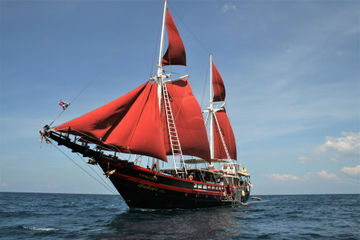Diving in Myanmar
Formerly known as Burma, Myanmar is a lesser known dive destination but can reward the intrepid traveler with some amazing diving. The Mergui Archipelago hosts dive sites not frequented often by mass tourism.
Scuba diving in Myanmar is a very fulfilling experience; there is so much on offer here reefs, walls, drift dives, sea mounts, caves, cavern zones, and monumental drop-offs. Most of Myanmar has yet to see any negative human influences, the region remains untouched and in perfect condition. The best of Myanmar scuba diving is embodied by the archipelagic islands that include the Burma Banks, and the Mergui Archipelago. One of the main reasons for scuba diving in Myanmar is to sample the incredible variety of pelagic species that can be seen throughout the entire dive season, including whale sharks.
There are 4 main language groups in Myanmar, and over 130 dialects within those groups. The land here is rich in natural resources of jade and gems, as well as oil and natural gas. Around a third of Myanmarís border is coastline, meeting the Bay of Bengal to the east, and the Andaman Sea to the west. Within the Mergui Archipelago, only 2 of the 800 islands are inhabited by Moken locals. It is likely that humans have never even set foot on the overwhelming majority of islands here, and although these islands appear on a map, most have never even been surveyed. All this leads to a richness in marine life in fantastic health and pristine condition.
2 Liveaboards in MyanmarExplore all liveaboards
Diving in Myanmar FAQ
What marine life can I expect to see in Myanmar?
Previously known a Burma, Myanmar scuba diving attracts the attention of those seeking large pelagic species found in the open ocean. Grey, oceanic whitetip, blacktip, nurse and leopard sharks are all fairly prevalent in most dive spots. There have even been sightings of the incredibly powerful bull shark and the highly intelligent orca.
In recent times, though, Myanmar's reputation for holding smaller and macro species is growing, especially as more sites are discovered and explored. Nudibranchs, ornate ghost pipefish, many species of shrimp including the intricately detailed harlequin shrimp, are present on these dive locations.
What are the best dive sites in Myanmar?
The Burma Banks are found approximately 280 km north of Phuket, and 60 km west of Kawthaung. This area of the ocean is very rarely visited, and it is possible to spend entire dive trips without seeing a single person outside of your liveaboard, let alone anyone else scuba diving on your sites. Most dives start at around 60 feet (15 m), and the slopes of the seamounts descend beyond 1150 feet (350 m). You will be greeted by huge table corals, usually with small shoals of reef fish encircling above. Limestone rocks are covered by black corals, while many species of shark patrol the reefs.
Mergui Archipelago is a huge island chain in the Andaman Sea, found along the western shores of the Malay Peninsula. The islands are so inaccessible that much of this area has yet to be explored. The islands consist of mostly limestone and granite rocks, creating stunning formations of ledges, caves, overhangs and swim-throughs, perfect for scuba diving in. Black rock is a particularly noteworthy site, attracting mobula rays and leopard sharks. The density of corals on this site is higher than almost anywhere else in the Andaman sea. Hiding in amongst the corals, you will find fantastically coloured hawkfish and pufferfish, while blue ringed angelfish flutter past. Banded sea snakes and several species of eel are usually found in cracks and crevices. In some areas, you can see just how susceptible limestone is to saltwater erosion, turning limestone formations into nothing more than a skeletal shell. This provides fantastic shelter for juvenile species and the entire system is supported by a ready supply of nutrients carried from depth by strong currents.
What's the best time to dive in Myanmar?
As is customary for Myanmar, scuba diving season opens in October and continues until May (usually from the 15th to the 15th). After which, sea conditions will become changeable, especially in exposed sites. The best time to visit is usually between December and April, when seas are typically calm and there is very little in the way of weather. Between February and May, you are most likely to see whale sharks and manta rays, and this is also when visibility will drop due to the blooms of plankton. The beginning of the scuba diving season sees the coolest water temperatures at 81 Fahrenheit (27C), which gradually warms to 86 Fahrenheit (30C) towards the end of the diving season. Visibility is consistently in excess of 100 feet (30 m), although it dips slightly on account of the plankton blooms.
What's the recommended experience level for diving in Myanmar?
Myanmar scuba diving is characterised by its remoteness. On many sites here, you will likely not see any signs of human activity. There are some safety considerations to acknowledge when scuba diving somewhere so remote, and this is why some of the most beautiful dive sites are rarely visited. Strong currents are prevalent around most dive sites in Myanmar and are susceptible to shift direction and even pull downwards. Dive tours to the Mergui Archipelago and especially the Burma Banks are infrequent. As such, it is recommended that only intermediate to advanced divers embark on dive trips to Myanmar.
How do I get to Myanmar?
Myanmar remains a fairly inaccessible and very isolated location, and it is not often visited by liveaboards. However, most dive cruises that sail in Myanmar waters will usually depart from either Phuket, Ranong or Khao Lak in Thailand. All ports are easily accessible; many direct international flights are now available to Phuket International Airport. Long-haul flights will usually require a connection, normally via Bangkok, but may also be made through Singapore, Sydney, Hong Kong, United Arab Emirates or Moscow.
If choosing a Myanmar liveaboard you will usually board in Khao Lak or Ranong entailing an additional 100 km drive to the north, once you have landed in Phuket, Thailand. Many liveaboards will be able to provide a shuttle service directly from the airport, and it is also possible to rent a car, or catch a bus, depending on your budget. The journey is usually no more than 1.5 hours, and follows a beautiful coastal road along Highway 402, which merges into Highway 4. For those who choose to drive, most signs are posted in both Thai and English.








